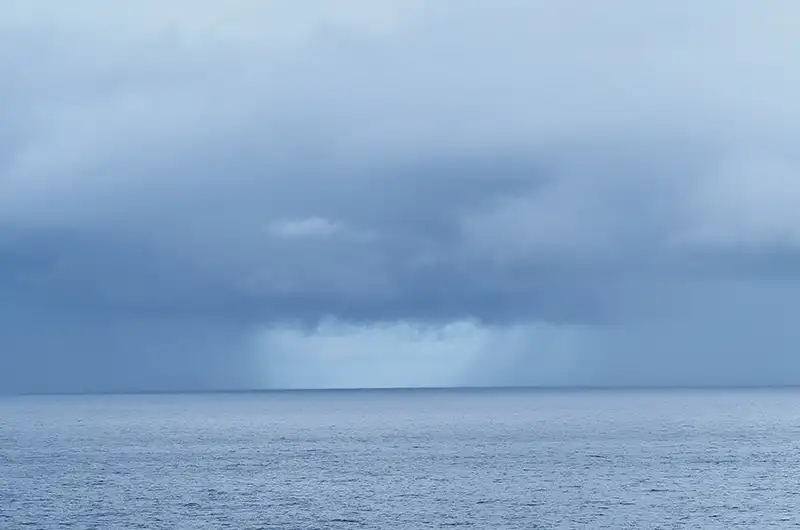
Squalls are one of boating’s most unpredictable hazards.
Imagine a beautiful day on the water with sunshine and calm seas stretching out around you. Suddenly, dark clouds gather rapidly, the wind picks up sharply, and in moments, you’re caught in a fierce squall. Thankfully, with preparation and know-how, you can safely manage these sudden storms. Here’s everything you need to know.
What is a Squall
A squall is a fast-moving storm that can last 10 to 40 minutes with possible wind gusts over 22 knots, and often includes rain, lightning, thunder, and wind shifts. Boaters can identify a squall by sudden chaotic weather conditions and reduced visibility.
Why Squalls Matter
Squalls pose serious risks precisely because of their unpredictability and rapid onset. They can easily catch boaters off guard, turning an otherwise pleasant outing into a dangerous situation. The biggest risks? Capsizing, loss of vessel control, equipment damage, and/or collisions due to limited visibility.
How to Spot a Squall
Boaters can recognize squalls before they hit by watching for these telltale signs:
- Sudden Wind Shifts: Wind quickly picks up and can drastically shift direction.
- Cloud Formations: Ominous, tall clouds with dark, flat bases are a clear warning.
- Rain Patterns: Dark streaks of rain beneath the clouds, often slanted due to strong winds.
- Sea Conditions: Rapid appearance of whitecaps, increased wave steepness, and spray.
- Temperature Drops: A noticeable drop in air temperature just before the storm hits.
The “calm before the storm” isn’t just a saying, winds might briefly lull before a powerful squall strikes.
How Squalls Form
Squalls typically arise from thunderstorm activity, particularly along cold fronts or during summer afternoons due to convective heating. They frequently appear as “squall lines” or bands of thunderstorms that can extend for miles. Knowing this can help boaters anticipate the hazard.
What You’ll Experience in a Squall
Being in a squall is intense:
- Rapid Wind Increase: Winds commonly reach 20-40 knots with gusts potentially hitting 50-60 knots.
- Reduced Visibility: Torrential rain or sea spray can cut visibility to nearly zero.
- Building Seas: Waves quickly become steep and choppy.
- Chaos on Deck: Sudden shifts and noise from thunder can be disorienting.
Risks of Getting Caught in a Squall
These conditions can quickly create dangerous situations:
- Capsizing or Broaching: Sudden, steep waves or high winds can force a boat broadside, causing dangerous instability or even rollover.
- Loss of Control: Strong winds and rough seas can make steering difficult, reducing your ability to keep the boat on course.
- Equipment Damage: Antennas, canvas tops, electronics, or unsecured gear can be damaged or lost in heavy wind and spray.
- Swamping: Powerful waves crashing over the bow or sides can flood the boat.
Proactive Safety is Your Best Defense
Prevention is always better than reaction. Here’s how to stay ahead of a squall:
Pre-Voyage and On-Water Vigilance
- Check marine forecasts frequently, with special attention to thunderstorm and squall warnings.
- Keep a constant watch on the horizon and use onboard radar or reliable weather apps to track changing conditions.
- Test bilge pumps to confirm they are operational before heading out.
Vessel and Crew Preparation
- Secure all loose gear on deck and stow items that could become hazardous in rough seas.
- Close hatches, windows, and compartments to prevent water from entering the vessel.
- Make sure everyone on board is wearing a properly fitted PFD.
Making the Right Call
- When possible, seek shelter in a protected harbor or safe anchorage before the squall hits.
- If caught offshore, reduce speed and head into the waves at a slight angle (about 30–45 degrees) to maintain control and lessen impact.
- Avoid hesitation—either commit to safe harbor or prepare to ride it out confidently in open water.
Essential Tools for Squall Safety
Equip your vessel with these crucial safety tools:
- VHF Marine Radio: For real-time weather broadcasts and emergency communication.
- Radar and Weather Apps: Radar helps track squalls and inclement weather.
- Personal Locator Beacon (PLB): A life-saving device in extreme emergencies.
- Reliable Ground Tackle: Ensure you have a robust anchor and sufficient rode.
Key Takeaway
Squalls are formidable but manageable with proper vigilance, preparation, and proactive seamanship. Equipped with the right knowledge and tools, you can ensure your boating adventures remain safe and enjoyable, even if the weather turns.
